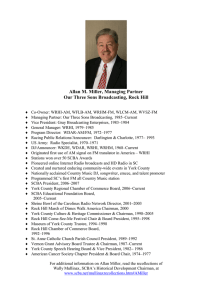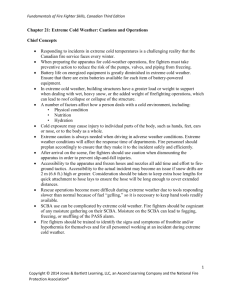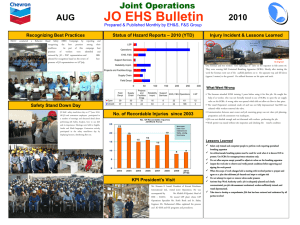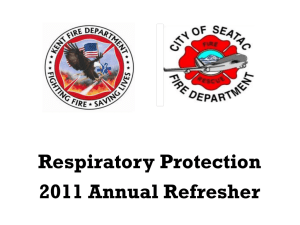Donning and Doffing SCBA
advertisement
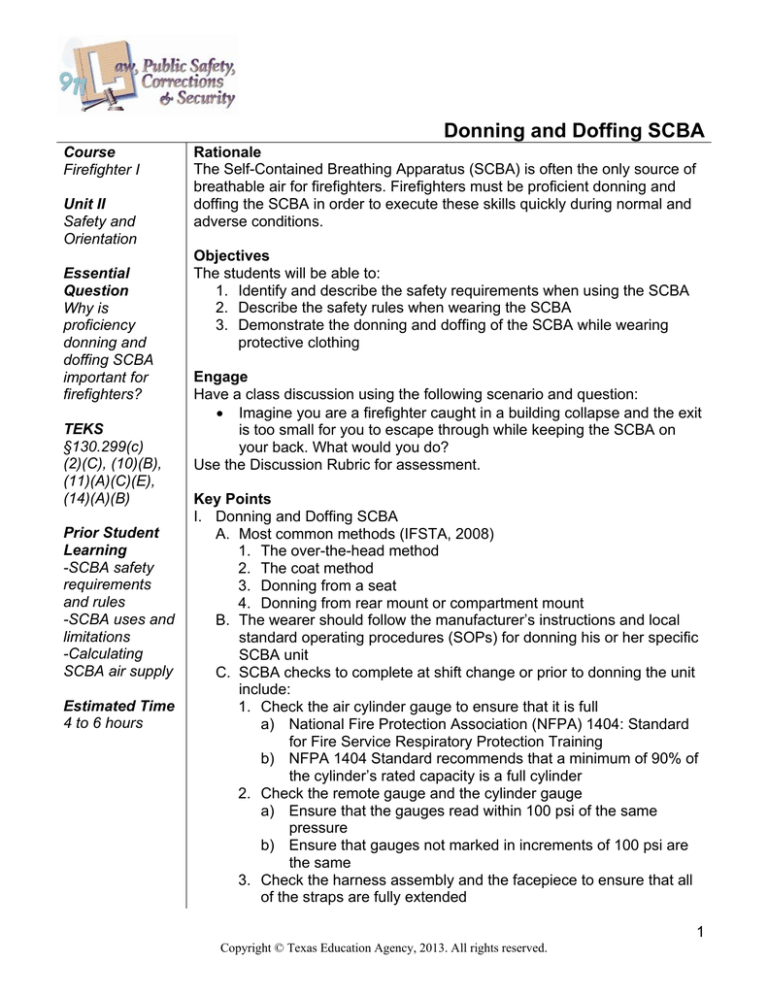
Donning and Doffing SCBA Course Firefighter I Unit II Safety and Orientation Essential Question Why is proficiency donning and doffing SCBA important for firefighters? TEKS §130.299(c) (2)(C), (10)(B), (11)(A)(C)(E), (14)(A)(B) Prior Student Learning -SCBA safety requirements and rules -SCBA uses and limitations -Calculating SCBA air supply Estimated Time 4 to 6 hours Rationale The Self-Contained Breathing Apparatus (SCBA) is often the only source of breathable air for firefighters. Firefighters must be proficient donning and doffing the SCBA in order to execute these skills quickly during normal and adverse conditions. Objectives The students will be able to: 1. Identify and describe the safety requirements when using the SCBA 2. Describe the safety rules when wearing the SCBA 3. Demonstrate the donning and doffing of the SCBA while wearing protective clothing Engage Have a class discussion using the following scenario and question: Imagine you are a firefighter caught in a building collapse and the exit is too small for you to escape through while keeping the SCBA on your back. What would you do? Use the Discussion Rubric for assessment. Key Points I. Donning and Doffing SCBA A. Most common methods (IFSTA, 2008) 1. The over-the-head method 2. The coat method 3. Donning from a seat 4. Donning from rear mount or compartment mount B. The wearer should follow the manufacturer’s instructions and local standard operating procedures (SOPs) for donning his or her specific SCBA unit C. SCBA checks to complete at shift change or prior to donning the unit include: 1. Check the air cylinder gauge to ensure that it is full a) National Fire Protection Association (NFPA) 1404: Standard for Fire Service Respiratory Protection Training b) NFPA 1404 Standard recommends that a minimum of 90% of the cylinder’s rated capacity is a full cylinder 2. Check the remote gauge and the cylinder gauge a) Ensure that the gauges read within 100 psi of the same pressure b) Ensure that gauges not marked in increments of 100 psi are the same 3. Check the harness assembly and the facepiece to ensure that all of the straps are fully extended 1 Copyright © Texas Education Agency, 2013. All rights reserved. 4. Operate all the valves a) Ensure that they operate properly b) Ensure that they are in the correct position 5. Check the personal alert safety system (PASS) device manually for proper operation D. Donning SCBA from a storage case or apparatus compartment 1. The specific SCBA manufacturer’s recommendations for donning and use of the SCBA should always be followed 2. Over-the-head method a) Position the SCBA with the valve end of the cylinder away from the user b) Open the cylinder valve fully c) Check the cylinder and the remote pressure gauges (1) Pressure readings must be within 100 psi (2) Needles on both gauges indicate the same pressure for gauges without 100 psi increments d) Raise the SCBA overhead while guiding your elbows into the loops formed by the shoulder straps e) Release the harness assembly and allow the SCBA to slide down your back f) Fasten the chest strap, buckle the waist strap, and adjust the shoulder straps g) Don the facepiece and check the facepiece seal h) Connect the air supply to facepiece i) Activate the PASS device if it is not integrated in the system j) Don the hood, the helmet, and the gloves 3. Coat method a) Position the SCBA with the valve end of the cylinder away from the user b) Open the cylinder valve fully c) Check the cylinder and the remote pressure gauges (1) Pressure readings must be within 100 psi (2) Needles on both gauges indicate the same pressure for gauges without 100 psi increments d) Grasp the top of the left shoulder strap on the SCBA with your left hand and raise the SCBA overhead e) Guide your left elbow through the loop formed by the left shoulder strap and swing the SCBA around your left shoulder f) Guide your right arm through the loop formed by the right shoulder strap allowing the SCBA to come to rest in the proper position g) Fasten the chest strap, the buckle waist strap, and adjust the shoulder straps h) Don the facepiece and check the facepiece seal i) Connect the air supply to the facepiece j) Activate the PASS device if it is not integrated in the system 2 Copyright © Texas Education Agency, 2013. All rights reserved. k) Don the hood, the helmet, and the gloves E. Donning seat-mounted SCBA 1. Firefighters can don SCBA while en route to an incident 2. It must be performed safely without the firefighter unbuckling his or her seatbelt 3. Three main types of seat-mounting hardware are a) Lever clamp b) Spring clamp c) Flat hook 4. Facepiece should be in a quick-opening bag to protect it from dust and scratches 5. Do not keep the facepiece connected to the regulator during storage a) These parts must be separate in order to check for a proper facepiece seal 6. Procedure to don seat-mounted SCBA a) Open the cylinder valve fully b) Check the cylinder and the remote gauge readings (1) Pressure readings must be within 100 psi (2) Needles on both gauges indicate the same pressure for gauges without 100 psi increments c) Position your body in the seat with your back firmly against the SCBA and release the SCBA hold-down device d) Insert your arms through the shoulder straps e) Fasten the chest straps, buckle the waist strap, and adjust the shoulder straps f) Fasten your seat belt before the apparatus moves g) Don the facepiece and check the facepiece seal h) Connect the air supply to the facepiece when you are ready to use it i) Activate the PASS device manually if it is not integrated in the system j) Don the hood, the helmet, and the gloves 7. Exit the fire apparatus carefully to avoid slips or falls due to the extra weight on your back F. Donning SCBA from a Side or Rear Mount 1. Takes more time than the seat-mounted SCBA 2. Reduces the chances of slips and falls 3. Saves time compared to SCBA stored in the carrying case due to the elimination of the following steps a) Removing the equipment case from the fire apparatus b) Placing it on the ground c) Opening the case d) Picking up the unit to don 4. Because these units are exposed to weather and physical damage, waterproof covers are desirable 3 Copyright © Texas Education Agency, 2013. All rights reserved. 5. Donning steps are similar to seat-mounted units because firefighters only have to back into them G. Donning from a Compartment or a Back-up Mount 1. Compartment mounts present the same advantages as side or rear-mounted units 2. Some disadvantages a) Some compartments are too high to back into b) Some compartment doors may interfere with donning 3. Back-up mounts provide quick access to SCBA 4. If back-up mounts are too high, they need to be removed and donned using the over-the-head method or the coat method 5. Back-up units at the right height can be donned similarly to the seat-mounted units H. Donning the Facepiece 1. Important differences between facepieces a) Some use a rubber harness with adjusting straps b) Some use a mesh skullcap with adjusting straps c) Some have a different number of adjusting straps d) The regulator may attach in different ways (1) May attach to the facepiece (2) May be mounted on the waist belt 2. Interchanging facepieces, or any other part of the SCBA, from one manufacturer’s equipment to another voids any warranty and certification (IFSTA, 2008) 3. NFPA 1500 requires that each firefighter be fitted with a facepiece that conforms properly to the shape and size of his or her face 4. General considerations for donning all SCBA facepieces a) Ensure that no hair comes between your skin and the sealing surface of the facepiece b) Place your chin in the center of the chin cup and center the harness at the back of your head c) Tighten the facepiece straps by pulling them evenly and simultaneously (1) Remember that pulling the straps outward may damage them (2) Tighten the straps in this order (a) The lower straps (b) The temple straps (c) The top strap (if present) d) Check the facepiece for proper seal and operation (1) Ensure that the exhalation valve is functioning properly (2) Ensure that all connections are secure (3) Ensure that the donning mode switch (if present) is in the proper position e) Check the positive pressure by gently breaking the facepiece seal 4 Copyright © Texas Education Agency, 2013. All rights reserved. (1) Insert two fingers under the edge of the facepiece (2) Confirm that you feel air moving past your fingers (3) If you cannot feel air movement, remove the unit from service and tag it for repair f) Wear the hood over the facepiece harness or straps (1) All exposed skin must be covered (2) Vision must not be obstructed g) Wear the helmet with the chin strap secured I. Doffing SCBA 1. Doffing techniques differ for different types of SCBA 2. Actions that apply to all SCBA when doffing a) Doffing SCBA Remove the backpack assembly while protecting the regulator b) Close the cylinder valve c) Relieve pressure from the regulator in accordance with the manufacturer’s instructions d) Extend all of the straps e) Refill or replace the cylinder f) Clean and disinfect the facepiece g) Doffing SCBA Skill (IFSTA, 2008) (1) Remove the SCBA (2) Close the cylinder valve completely (3) Bleed air from the high- and low-pressure hoses (4) Check the air cylinder pressure and replace the cylinder if it has less than 90% of rated capacity (5) Return all the straps, valves, and components back to the ready state (6) Inspect the SCBA and facepiece for damage and/or needed cleaning (7) Clean the equipment as needed, remove the damaged equipment from service, and report it to an officer, if applicable (8) Place the SCBA back into the storage area so that it is ready for immediate use Activities Donning SCBA – Introduction: Re-engage the students by reviewing the components and limitations of the SCBA. Demonstrate donning the SCBA using the over-thehead method and the coat method. Stress the importance of safety checks (i.e. cylinder pressure, low-air alarm, PASS device, remote gauge within 100 psi, and good face seal). (Note: This activity is designed for groups with limited SCBA resources. If you can assign to each student an SCBA with a mask, the students can practice the entire donning procedure from the beginning.) 5 Copyright © Texas Education Agency, 2013. All rights reserved. Instructions: Divide your class into groups (ideally 5 students per group). Assign a leader to each group that is responsible for the group’s learning. If possible, assign each member his or her own SCBA mask; if this is impossible, assign each group a mask and demonstrate how to properly disinfect the mask between users. Assign one SCBA unit per student if possible; if not, then one per group. Have the students with SCBAs don the cylinder and secure the shoulder straps and waist straps within 20 seconds. (Note: Have each student repeat this until the time limit is successfully met.). At the same time, have the students with the masks complete the following while in a kneeling position: remove their helmets, put on their masks, check for a good seal, don their hoods, and then don their helmets. (Note: Have each student repeat this until the time limit is successfully met.). Have the students rotate between donning the cylinder and the mask until they are proficient. Assign an SCBA and a mask to each student or group. Have the students combine the donning procedures of the cylinder and the mask. Each student should complete the following tasks within one minute: Read the cylinder pressure Open the cylinder valve Acknowledge that the low-air alarm and the PASS device are working Verify that the remote gauge and the cylinder gauge are within 100 psi Don the SCBA cylinder using one of the methods Don the mask Check for a good seal Don the hood Don the helmet Connect the air supply to the mask Don the gloves Remind the students that they have to practice repeatedly. Use the following checklists for assessment: Donning SCBA Using the Coat-Method Checklist Donning SCBA Using the Over-the-Head Method Checklist Donning SCBA Using the Seat-Mounted Method Checklist Peer Evaluation Assessments Donning and Doffing SCBA Quiz and Key Donning SCBA Using the Coat-Method Checklist Donning SCBA Using the Over-the-Head Method Checklist Donning SCBA Using the Seat-Mounted Method Checklist Peer Evaluation Discussion Rubric Individual Work Rubric Materials 6 Copyright © Texas Education Agency, 2013. All rights reserved. Donning and Doffing SCBA computer-based presentation Personal Protective Equipment (PPE) Self-Contained Breathing Apparatus (SCBA) Pens and paper, or computers with presentation software Computers with Internet access or other resources for research Resources 0135151112, Essentials of Firefighting and Fire Department Operations (5th Edition), International Fire Service Training Association (IFSTA), 2008. Accommodations for Learning Differences For reinforcement, students will write and memorize the steps for the methods of donning SCBA or create a computer-based presentation illustrating the procedures. Use the Individual Work Rubric for assessment. For enrichment, students will research the SCBA manufacturer’s specifications and summarize their findings. Use the Individual Work Rubric for assessment. State Education Standards Texas Essential Knowledge and Skills for Career and Technical Education §130.299. Firefighter I (One to Two Credits). (2) The student executes safety procedures and protocols associated with fire management services. The student is expected to: (C) practice personal safety procedures. (10) The student analyzes the internal systems that sustain life in the human body and identifies the physical requirements of a self-contained breathing apparatus wearer. The student is expected to: (B) analyze the National Fire Protection Association standards applicable to the self-contained breathing apparatus; (11) The student demonstrates confidence in performing fire fighting skills while wearing self-contained breathing apparatus. The student is expected to: (A) identify and describe the safety requirements when using the self-contained breathing apparatus; (C) describe the safety rules when wearing the selfcontained breathing apparatus; (E) demonstrate the donning and doffing of the selfcontained breathing apparatus while wearing protective clothing; (14) The student demonstrates the proper testing and operation of a personal alert safety system device. The student is expected to: 7 Copyright © Texas Education Agency, 2013. All rights reserved. (A) (B) explain the proper operation of a safety device; and demonstrate the proper testing of a safety device. Career and College Readiness Standards Cross-Disciplinary Standards I. Key Cognitive Skills C. Problem solving 1. Analyze a situation to identify a problem to be solved. 2. Develop and apply multiple strategies to solve a problem. 8 Copyright © Texas Education Agency, 2013. All rights reserved. Name ________________________________ Date ___________________ Donning and Doffing SCBA Quiz 1. _____Which of the following is the most common method of donning SCBA? A. Over-the-head method B. Coat method C. Seat-mounted method D. All of the above 2. _____According to NFPA 1404, a full SCBA cylinder is filled to no less than _____% of its rated capacity. A. 70 B. 75 C. 80 D. 90 3. _____When checking an SCBA unit, check the remote gauge and cylinder gauge to ensure they read within ________ psi. A. 100 B. 200 C. 300 D. 500 4. _____When donning the SCBA using the over-the-head method, position the SCBA with the cylinder valve end ____________________. A. Towards you B. Next to you C. Away from you D. At your side 5. _____When donning the SCBA, always open the cylinder valve fully. A. True B. False 6. _____An advantage of seat-mounted SCBA is that you can don it en route to an incident. A. True B. False 7. _____It is safe and proper to interchange SCBA components from different manufacturers. A. True B. False 9 Copyright © Texas Education Agency, 2013. All rights reserved. 8. _____Firefighters should not wear a beard because ________________. A. It looks shabby B. It interferes with the SCBA facepiece seal C. Firefighters may wear beards D. None of the above 9. _____Which of the following is NOT an action that applies to doffing all SCBA? A. Activate your PASS device B. Make sure you are out of the contaminated area C. Close the cylinder valve D. Discontinue air flow from the regulator to the facepiece 10. _____When changing cylinders, which of the following should be placed on the ground to protect the spare cylinders? A. Carrying case B. Section of hose C. Salvage cover D. None of the above 10 Copyright © Texas Education Agency, 2013. All rights reserved. Donning and Doffing SCBA Quiz Key 1. 2. 3. 4. 5. 6. 7. 8. 9. 10. D D A C A A B B A C 11 Copyright © Texas Education Agency, 2013. All rights reserved. Name:_________________________ Date:___________________________ Donning SCBA Using the Coat-Method Checklist 1 pt. each Task steps Position the SCBA with the valve end of the cylinder away from your body Open the cylinder valve fully and acknowledge that the low-air alarm and the PASS device are activated Check the cylinder and the remote gauge pressures and verbalize “within 100 psi” or “both gauges same pressure” Grasp the top of the left shoulder strap on the SCBA with your left hand and raise the SCBA overhead Guide your left elbow through the loop formed by the left shoulder strap and swing the SCBA around your left shoulder Guide your right arm through the loop formed by the right shoulder strap allowing the SCBA to come to rest on your back Fasten the chest strap, buckle the waist strap, and adjust the shoulder straps Don the facepiece and check the facepiece seal Connect the air supply to the facepiece Activate the PASS device if it is not integrated into the system Don the hood, helmet, and gloves Total points (11 possible pts.) Comments: 12 Copyright © Texas Education Agency, 2013. All rights reserved. Name:_________________________ Date:___________________________ Donning SCBA Using the Over-the-Head Method Checklist 1 pt. each Task steps Position the SCBA with the valve end of the cylinder away from your body Open the cylinder valve fully and acknowledge that the low-air alarm and the PASS device are activated Check the cylinder and the remote gauge pressures and verbalize “within 100 psi” or “both gauges same pressure” Raise the SCBA overhead while guiding your elbows into the loops formed by the shoulder straps Release the harness assembly and allow the SCBA to slide down your back Fasten the chest strap, buckle the waist strap, and adjust the shoulder straps Don the facepiece and check the facepiece seal Connect the air supply to the facepiece Activate the PASS device if it is not integrated into the system Don the hood, helmet, and gloves Total points (10 possible pts.) Comments: 13 Copyright © Texas Education Agency, 2013. All rights reserved. Name:_________________________ Date:___________________________ Donning SCBA Using the Seat-Mounted Method Checklist 1 pt. each Task steps Open the cylinder valve fully and acknowledge that the low-air alarm and the PASS device are activated Check the cylinder and remote gauge pressures and verbalizes “within 100 psi” or “both gauges same pressure” Position your body in the seat with your back firmly against the SCBA and release the SCBA hold-down device Insert your arms through the shoulder straps Fasten the chest strap, buckle the waist strap, and adjust the shoulder straps Fastens your seat belt before the apparatus moves Don the facepiece and check the facepiece seal Connect the air supply to the facepiece when you are ready to use it Activate the PASS device if it is not integrated into the system Don the hood, helmet, and gloves Total points (10 possible pts.) Comments: 14 Copyright © Texas Education Agency, 2013. All rights reserved. Your Name___________________________________ Your Group Number_______ Peer Evaluation 1) Name of Student________________________________________ At what level of seriousness did they take this activity? Not Very Serious Very Serious 0 1 2 3 4 Did they make a significant contribution to the brainstorming process? No Yes 0 1 2 3 4 Did they make a significant contribution to preparing for the activity? No Yes 0 1 2 3 4 What was the level of their participation in the activity(s)? None A Lot 0 1 2 3 4 Would you want to work with this person in a group again based on their level of productivity? No Yes 0 1 2 3 4 Total Score_______ 2) Name of Student________________________________________ At what level of seriousness did they take this activity? Not Very Serious Very Serious 0 1 2 3 4 Did they make a significant contribution to the brainstorming process? No Yes 0 1 2 3 4 Did they make a significant contribution to preparing for the activity? No Yes 0 1 2 3 4 What was the level of their participation in the activity(s)? None A Lot 0 1 2 3 4 Would you want to work with this person in a group again based on their level of productivity? No Yes 0 1 2 3 4 Total Score_______ 15 Copyright © Texas Education Agency, 2013. All rights reserved. 3) Name of Student________________________________________ At what level of seriousness did they take this activity? Not Very Serious Very Serious 0 1 2 3 4 Did they make a significant contribution to the brainstorming process? No Yes 0 1 2 3 4 Did they make a significant contribution to preparing for the activity? No Yes 0 1 2 3 4 What was the level of their participation in the activity(s)? None A Lot 0 1 2 3 4 Would you want to work with this person in a group again based on their level of productivity? No Yes 0 1 2 3 4 Total Score_______ 4) Name of Student________________________________________ At what level of seriousness did they take this activity? Not Very Serious Very Serious 0 1 2 3 4 Did they make a significant contribution to the brainstorming process? No Yes 0 1 2 3 4 Did they make a significant contribution to preparing for the activity? No Yes 0 1 2 3 4 What was the level of their participation in the activity(s)? None A Lot 0 1 2 3 4 Would you want to work with this person in a group again based on their level of productivity? No Yes 0 1 2 3 4 Total Score_______ 16 Copyright © Texas Education Agency, 2013. All rights reserved. 5) Name of Student________________________________________ At what level of seriousness did they take this activity? Not Very Serious Very Serious 0 1 2 3 4 Did they make a significant contribution to the brainstorming process? No Yes 0 1 2 3 4 Did they make a significant contribution to preparing for the activity? No Yes 0 1 2 3 4 What was the level of their participation in the activity(s)? None A Lot 0 1 2 3 4 Would you want to work with this person in a group again based on their level of productivity? No Yes 0 1 2 3 4 Total Score_______ 6) Name of Student________________________________________ At what level of seriousness did they take this activity? Not Very Serious Very Serious 0 1 2 3 4 Did they make a significant contribution to the brainstorming process? No Yes 0 1 2 3 4 Did they make a significant contribution to preparing for the activity? No Yes 0 1 2 3 4 What was the level of their participation in the activity(s)? None A Lot 0 1 2 3 4 Would you want to work with this person in a group again based on their level of productivity? No Yes 0 1 2 3 4 Total Score_______ 17 Copyright © Texas Education Agency, 2013. All rights reserved. Name_______________________________________ Date_______________________________ Discussion Rubric Objectives 4 pts. Excellent 3 pts. Good 2 pts. Needs Some Improvement 1 pt. Needs Much Improvement N/A Pts. Participates in group discussion Encourages others to join the conversation Keeps the discussion progressing to achieve goals Shares thoughts actively while offering helpful recommendations to others Gives credit to others for their ideas Respects the opinions of others Involves others by asking questions or requesting input Expresses thoughts and ideas clearly and effectively Total Points (32 pts.) Comments: 18 Copyright © Texas Education Agency, 2013. All rights reserved. Name______________________________________ Date_______________________________________ Individual Work Rubric 4 pts. Excellent Objectives 3 pts. Good 2 pts. Needs Some Improvement 1 pt. Needs Much Improvement N/A Pts. Follows directions Student completed the work as directed, following the directions given, in order and to the level of quality indicated Time management Student used time wisely and remained on task 100% of the time Organization Student kept notes and materials in a neat, legible, and organized manner. Information was readily retrieved Evidence of learning Student documented information in his or her own words and can accurately answer questions related to the information retrieved *Research/Gathering information (if relevant) Student used a variety of methods and sources to gather information. Student took notes while gathering information Total Points (20 pts.) Comments: 19 Copyright © Texas Education Agency, 2013. All rights reserved.
